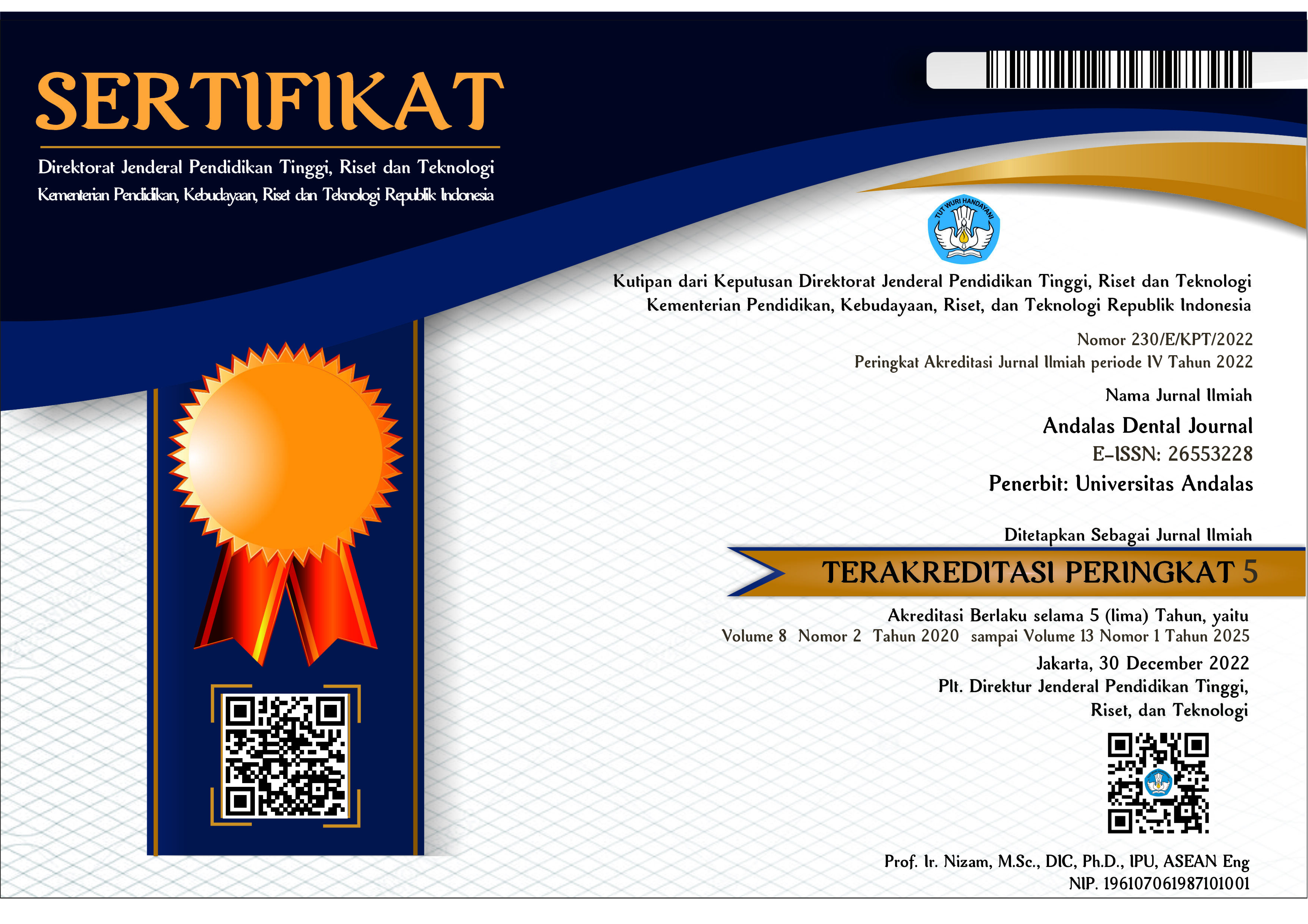Hubungan Pengetahuan Ibu Tentang Pertumbuhan Gigi dengan Kasus Persistensi pada Anak Usia 7-11 Tahun di Wilayah Kerja Puskesmas Andalas
Abstract
Objective: Over-retained tooth is condition when the primary tooth as retainer of the permanent tooth not exfoliate promptly, while permanent tooth has been erupted. The oral health problems in Padang reported anomalies of tooth development and eruption were in the second place with 8.897 cases in 2018. Andalas Public Health Center (PHC) possessed the highest number of over-retained tooth cases which becomes their primary problem in this category. Children's oral and dental health particularly over-retained tooth is largely determined by the awareness of their mothers’ behaviour and knowledge. The purpose of this study was to determine the correlation between mothers’ knowledge towards dentition and over-retained tooth during mixed dentition case on children aged 7-11 years in Andalas PHC area. Method: This study was analytical observation research with cross sectional design. There were 106 samples of children aged 7-11 years together with their mothers in Andalas PHC obtained by using simple random sampling. Data were collected through questionnaire and children's oral examination. Data were analyzed by the Chi-Square test. The results of this study showed that 54.7% of children in Andalas PHC area had over-retained tooth. The high level of mother's knowledge about dentition was 55.7% Result: The results of the analysis between the mother's knowledge of dentition and over-retained tooth obtained value of p = 0,0001. Conlusion: There was a significant correlation between mothers knowledge of dentition and occurrence of over-retained tooth among children aged 7-11 years in Andalas PHC area.
References
2. BPPK BP, PK. Laporan Nasional Riset Kesehatan Dasar 2018, 582; 2018.
3. DKK. Hasil Laporan Pelayanan Kesehatan Gigi 2018. Padang; 2019.
4. Millet D, Welbury, R.Orthodontics & Paediatric Dentistry 2nd Edition. London: Churchill Livingstone.; 2010.
5. Pratiwi A, Sulastri S, Hidayati S. Hubungan Tingkat Pengetahuan Orang Tua Tentang Jadwal Pertumbuhan Gigi Dengan Kejadian Persistensi Gigi Anak 6-10 Tahun Di SDN Wojo I Bantul. Jurnal Gigi Dan Mulut. 2014; 1(1): 12–18.
6. Riyanti E. Pengenalan Dan Perawatan Kesehatan Gigi Anak Sejak Dini; 2005.
7. Supartini L. Gambaran Pengetahuan Orang Tua Tentang Kasus Persistensi Gigi Sulung Di Puskesmas Cisarua Kecamatan Cisarua Kabupaten Bandung Barat. Poltekkes Kemenkes Bandung. Bandung: Poltekkes Kemenkes Bandung; 2012.
8. Nagaveni NB, Radhika NB, Umashankar KV. Knowledge, Attitude and Practices of Parents Regarding Primary Teeth Care of Their Children in Davangere City, India’, Pesq Bras Odontoped Clin Integr. 2011; 11(1): 29–132.
9. Yani RWE. Faktor-Faktor Yang Mempengaruhi Terjadinya Persistensi Gigi Pada Anak Usia 6-12 Tahun. Wahana Riset Kesehatan. 2016; VI (1): 30–32.
10. Danaei SM, Oshagh M, Pajuhi N, Ghahremani Y, Bushehri GS. Assessment of Parental Awareness About Malocclusion in Shiraz, Islamic Republic of Iran. Eastern Mediterranean Health Journal. 2011; 17(7): 599–603.
11. Deepika P, Suma S, Chand PD, Prinka S. Parental Awareness About Malocclusion in Their Children: A Common Yet Unknown Disorder. 2018; 17(2): 34–37.
12. Setty JV, Srinivasan I. Knowledge and Awareness of Primary Teeth and Their Importance Among Parents in Bengaluru City, India; 2016. p. 56–61.
13. Moss SJ. Paediatric Dentistry, The Journal of the American Dental Association; 2014.
14. Marimo C. Delayed Exfoliation of Primary Teeth Due to Second Pathoses Case Series Study. Medical Journal of Zambia. 2011; 36(2): 92–94.
15. Aktan AM, Kara İ, Şener İ, Bereket C, Çelik S, Kırtay M, Çiftçi ME, Arıcı N. An Evaluation of Factors Associated with Persistent Primary Teeth. European Journal of Orthodontics. 2012; 34: 208–212.
16. Srivastava VK. Modern Pediatric Dentistry 1st Edition. New Delhi: Jaypee Brothers Medical Publishers (P) Ltd; 2011.
17. Muslima TK, Ernawaty J, Woferst R. Faktor-Faktor yang Mempengaruhi Tingkat Pengetahuan Orang Tua terhadap Dampak Televisi pada Perkembangan Anak Usia Sekolah. 2011; 59: 2–6.
18. Ar-Rasily OK, Dewi PK. Faktor-Faktor Yang Mempengaruhi Tingkat Pengetahuan Orang Tua Mengenai Kelainan Genetik Penyebab Disabilitas Intelektual Di Kota Semarang. Jurnal Kedokteran Diponegoro. 2016; 5(4): 1422–1433.
19. Sariningrum E, Irdawati I. Hubungan Tingkat Pendidikan, Sikap dan Pengetahuan Orang Tua tentang Kebersihan Gigi dan Mulut pada Anak Balita 3 – 5 Tahun dengan Tingkat Kejadian Karies di Paud Jatipurno. Berita Ilmu Keperawatan. 2009; 2: 119–124.
20. Notoatmodjo, S. Metodologi Penelitian Kesehatan. Jakarta: Rineka Cipta; 2010.
Copyright (c) 2020 Aminatu Nur Rahma, Sri Ramayanti, Bambang Ristiono

This work is licensed under a Creative Commons Attribution-ShareAlike 4.0 International License.















